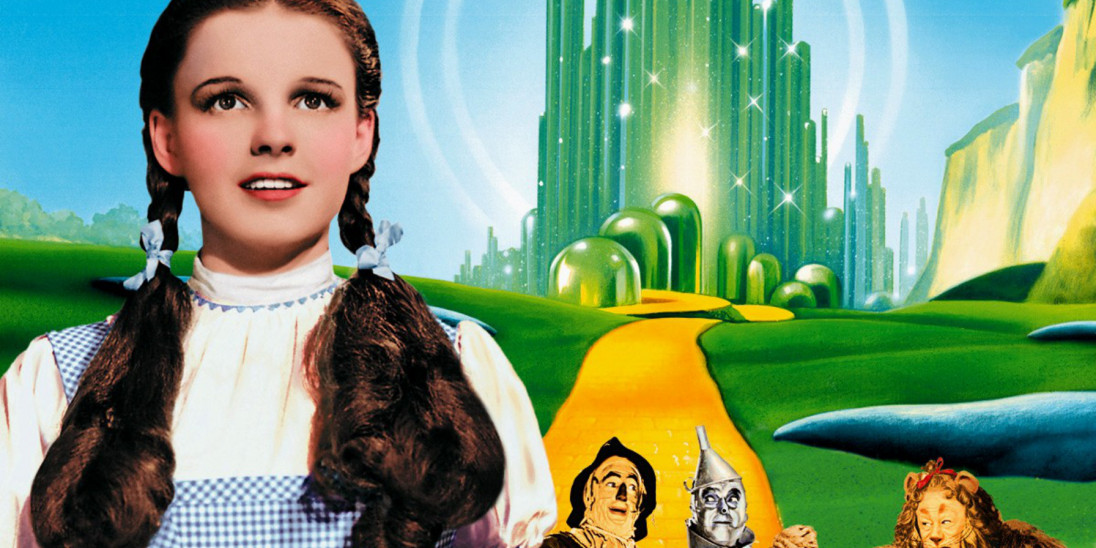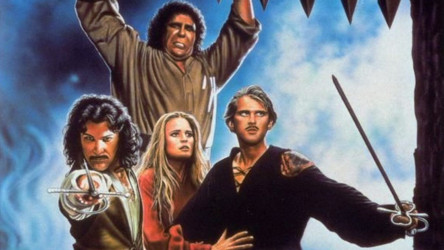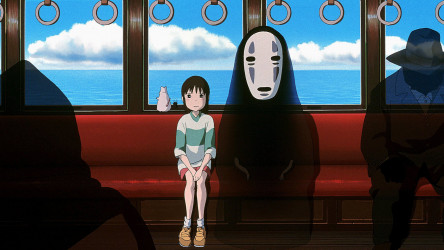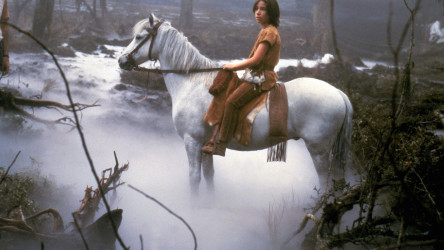The Wizard of Oz(1939)
Stream on Into Film+ Premium
One of early cinema's most beloved films sees a young girl called Dorothy, and her dog Toto, whisked away from Kansas to a fantastical land called Oz.
Certificate
Age group-
Duration98 mins



The Wizard Of Oz: Mise en Scene
The Wizard of Oz, a classic children’s book, full of adventure and mystery was made into a classic movie in 1939, starring Judy Garland as the lead. It follows the story of Dorothy, a young girl from Kansas, who was swept up in a hurricane and brought to Oz, a land of magic and bright colours, literally. As she ventures through Oz, she meets many characters, most of whom have their own song and receives a pair of ruby red slippers from the corpse of the Wicked Witch of the East, Dorothy was responsible for the manslaughter of her. Although Dorothy is memorized by Oz, she needs to get back to Kansas for her Auntie Em. Joined by the Tin Man, Scarecrow and Cowardly Lion, Dorothy makes her way to Emerald City to see ‘The Wizard of Oz’ to be granted her wish for a safe return to Kansas. Unfortunately, she faces many tasks and challenges thrown at her from the Wicked Witch of the West, sister to the Witch of the East.
However, they manage to overthrow the witch and enter the Emerald Palace to confront the Wizard with their wishes. The Scarecrow hopes for a brain, the Tin Man a heart and the Lion for courage. Eventually, all but Dorothy are granted their wishes, who realises that she had the power to go back home as ‘There’s no place like home.’ Dorothy arrives back home in Kansas, surrounded by her friends and family after an injury from the hurricane.
This movie has gone down from generation to generation as a family favourite and Judy’s song, ‘Somewhere Over the Rainbow’ has been performed many times on TV and played on thousands of radio stations since. The Mise En Scene in this film is outstanding, especially its use of colour and costume.
Colour
This movie uses colour to its full advantage. In Kansas, it is in black and white sepia, representing the boringness and ‘un-magicalness’ of a small farm; whereas Oz is full of bright, high-contrast colour. It was a crucial part for the colours to be so bright in Oz, not only because of it’s joyfulness, but because the famous landmarks are all based on one colour. The Emerald City, rich, lush green. The Yellow Brick road, goldy yellow. The Witches Castle, black, navy and grey. The poppy field, vibrant and muted reds. We can’t forget the famous ruby red slippers though.
Costumes
When I think of costume in the wizard if Oz, three people(s) come to mind, Glinda the Good Witch, The Wicked Witch of the West and (of course), The munchkins! Glinda is there to be the person who helps Dorothy understand how Oz works, and eventually, gets her back home. She wears a big, extravagant pink ball gown, consumed with sequins and a tall, regal crown towering on her head; her outfit really does convey her character, sweet, innocent and good. The Wicked Witch of the West is a polar opposite, enveloped in a black dress (with a Victorian silhouette) and pointed hat, she makes it rather obvious she is a stereotypical evil witch who rides an old broom. The only colour that stands out is her vibrant green skin. The green represents her jealousy towards Dorothy for being pretty, but more because she has the ruby red shoes. She is a juxtaposition when she arrives in the Munchkin’s town square.
The munchkins optimize Oz to me, the way they talk is high and squeaky and their clothes are even more bizarre. Most of the population are dressed in traditional German/European clothing, but doused in bright, over saturated colour. The munchkins of high authority though are wearing over dramatized costumes in various different shapes and colours; their hair is neatly shaven or pulled back into abstract shapes and curves. From spontaneous singing and dancing to giving formal speeches, these strange creatures of full of charisma and joy. Of course, though, we can not forget Dorothy. In the midst of all this craziness, she is wearing a simple blue checked pinafore and white shirt. The only tong that hints to Oz are her red slippers, which were given to her when she arrived there. This helps to find her as she actually stands out in the crowd of Munchkins!
Lighting
The lighting in this movie really does finish some scenes off. When Dorothy is safe, it is usually bright white, like when she first enters Oz or is in the Emerald Palace. But when she is in (or entering) danger, it becomes dark and heavily shadowed, like when she is in The Witch of the West’s castle or in the woods of apple trees. This is very important as from a young age, you are afraid of the dark, or at least a bit creeped out by the unknown. This movie is for all ages, but the bright colours will attract children mainly. They will easily be able to distinguish safe setting to dangerous settings as it is one of their fears.
Camera Angles
The Wizard of Oz uses so many different types of camera angles. They use the extreme longshot when showing the emerald palace and the farm in Kansas, they also add an aerial to an extreme long shot in the scene where the Tin Man, Scarecrow and Dorothy skip into the dark woods. A long shot is used when the Wizard of Oz is addressing the crowd about the hot air balloon nearer the end of the movie. A medium shot is when Glinda the Good Witch is introducing herself to Dorothy. There is an ‘over the shoulder shot’ of Dorothy watching the pink bubble float down from the sky; this could be counted as neutral, eye level or even POV, the point of the shot is to make you feel you are there in Oz. The scene where the ‘Lollipop Guild’ dance is a medium shot as it is a nearly full body shot but doesn’t include too much scenery in the background, this is effective as it shows their actions and dance clearly. They did not use many extreme close-ups.
Composition and Framing
Throughout the movie, the composition is either linear, face to face or in a crowded group of people. Almost all of the ‘Wizard Of Oz’ posters, they four main characters are normally skipping down the yellow brick road, linking arms in a line. They are all linking arms, the line is also in the ‘Lions, Tigers and Bears’ scene, however, the lion is not there, so Dorothy is in the middle and the ‘Lollipop Guild’ song. A face to face scene from the movie could be when Dorothy meets Glinda the Good Witch or when she meets the Scarecrow. The crowded scenes include the Munchkin town, inside the Emerald Palace or when Dorothy returns to Kansas. The crowded scenes seem to have not much background in, making it a tight framing and it feels like you are there. The line scenes are normally a long shot, so they have room to move around the shot; this makes the movie feel more cinematic and professional.
I think this movie has a quality to it that makes it universally likeable, whether it's the songs, dance or story, you're never too old for a classic movie.
Print this review
Stream on Into Film+ Premium
An elderly man reads his grandson an exciting fairy tale about a princess living in a fictional kingdom and the many mysterious figures on her trail.
Certificate

Extraordinary, Oscar-winning fantasy animated film from Japan following the down-the-rabbit-hole adventures of a young girl named Chihiro.
Certificate

This epic fantasy adventure that sees a lonely boy suddenly become a character in a weird and wonderful book he has started to read.
Certificate